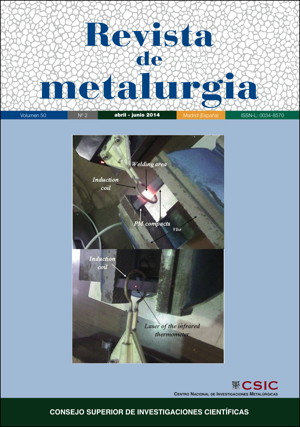Soldadura por inducción de ultra alta frecuencia de polvos de metal compactados
DOI:
https://doi.org/10.3989/revmetalm.016Palabras clave:
Hierro, Inducción, Polvos de metal compactados, Soldadura, Soldadura por inducción de ultra alta frecuenciaResumen
Soldadura por inducción de ultra alta frecuencia de polvos de metal compactados. Se ha realizado un estudio de la aplicación de polvos de metal (PM) de base hierro compactados por soldadura por inducción de ultra alta frecuencia (UHFIW). Estos polvos de metal compactados se utilizan para producir engranajes. Este estudio investiga los métodos de uni.n de los materiales de PM con UHFIW en su aplicación en la industria. La máxima tensión y la máxima deformación de los polvos de metal compactados soldados fueron determinadas por flexión en tres puntos y prueba de resistencia. Se determinó la microdureza y la microestructura de los polvos compactados por soldadura por inducción.
Descargas
Citas
Babkib, A.S., Sharapov, S.N. (2011). Modelling the strength of the magnetic field of welding current. Welding International 25 (4), 301–304. http://dx.doi.org/10.1080/09507116.2010.540883
Balaganskii, A.Y., Ivanaiskii, V.V. (2011). Modeling the process of induction surfacing of components with a variable cross section. Welding International 25 (9), 710–714. http://dx.doi.org/10.1080/09507116.2011.566746
Çavdar, U. (2009). Identification parameters for the induction sintered iron based powder metal compacts, PhD thesis, Celal Bayar University.
Çavdar, U., Atik, E. (2008). Sintering with induction. Euro PM 2008 Conference (3), 33–38.
Çavdar, U., Atik, E. (2009). Induction sintering of Fe - 2 Cu PM compacts. Euro PM2009 Conference, 13–19.
Çavdar, U., Atik, E. (2010). Induction sintering of % 3 Cu Contented Iron Based Powder Metal Parts. Modern Applied Science 4 (3), 63–70. http://dx.doi.org/10.5539/mas.v4n3p63
Çavdar, U., Atik, E. (2014a). Investigation of conventional - and induction - sintered iron and iron-based power metal compacts. JOM, Published online.
Çavdar, U., Atik, E. (2014b). Properties of boronized, carbonitrided and steamed iron-based compacts. Materials Testing 56 (2), 126–130. http://dx.doi.org/10.3139/120.110533
German, R.M. (1994). Powder metallurgy science, 2th Edition, MPIF, USA, pp. 400–403.
German, R.M. (1996). Sintering theory and practice, A Willey INC. USA, 313–362, 373–400, 403–420.
Gruszczyk, A. (2013). New possibilities for welding and surfacing of grey iron. Welding International 27 (12), 915–919. http://dx.doi.org/10.1080/09507116.2012.708481
Haimbaugh, R.F. (2001). Practical induction heat treating, ASM International, USA, pp.3–5, 165.
Kuznetsov, M.A., Zernin, E.A. (2012). Nanotechnologies and nanomaterials in welding production. Welding International 26 (4), 23–26. http://dx.doi.org/10.1080/09507116.2011.606158
Riera, M.D., Prado, J.M. (2006). Modelling of the plasticity in cold compaction of metal powders. Rev. Metal. 42 (6), 456–462. http://dx.doi.org/10.3989/revmetalm.2006.v42.i6.43
Shulyak, A.A., Startsev, A.V., Korovin, E.M., Korolkov, P.M. (2011). Local heat treatment of large welded pressure vessels by induction heating. Welding International 25 (8), 652–655. http://dx.doi.org/10.1080/09507116.2011.566741
Wu, M.W., Tsao, L.C., Shu, G.J., Lin, B.H. (2012). The effects of alloying elements and microstructure on the impact toughness of powder metal steels. Mat. Sci. Eng. A 538, 135–144. http://dx.doi.org/10.1016/j.msea.2011.12.113
Zinn, S., Semiatin, S.L. (1988). Elements of induction heating design, control and applications, EPRI, ASM International, USA, pp. 3, 12–13.
Publicado
Cómo citar
Número
Sección
Licencia
Derechos de autor 2014 Consejo Superior de Investigaciones Científicas (CSIC)

Esta obra está bajo una licencia internacional Creative Commons Atribución 4.0.
© CSIC. Los originales publicados en las ediciones impresa y electrónica de esta Revista son propiedad del Consejo Superior de Investigaciones Científicas, siendo necesario citar la procedencia en cualquier reproducción parcial o total.
Salvo indicación contraria, todos los contenidos de la edición electrónica se distribuyen bajo una licencia de uso y distribución “Creative Commons Reconocimiento 4.0 Internacional ” (CC BY 4.0). Consulte la versión informativa y el texto legal de la licencia. Esta circunstancia ha de hacerse constar expresamente de esta forma cuando sea necesario.
No se autoriza el depósito en repositorios, páginas web personales o similares de cualquier otra versión distinta a la publicada por el editor.
















